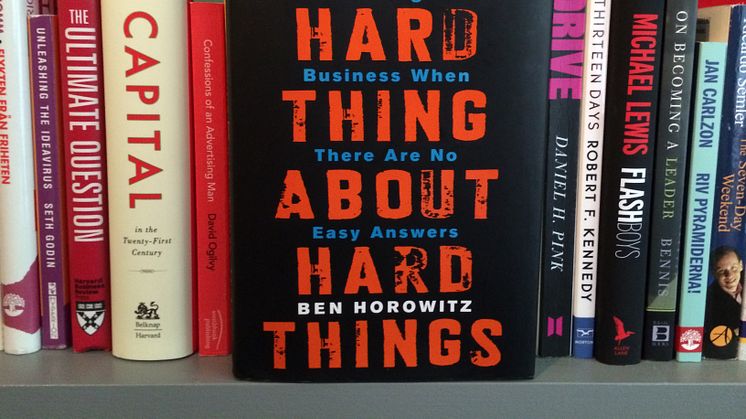
Blog post -
Top 10 Hard Things About Hard Things
Ben Horowitz’ book The Hard Thing About Hard Things is about being a CEO in struggling tech companies, and what he learnt the hard way. Here are our top 10 insights from this amazing story.
1. You will screw up
As an entrepreneur, I like to think that there are no management handbooks; you must write your own. There are thousands of books to read, yet the only way to learn is by doing, and failing. You don’t have to write an actual book, like Ben Horowitz, but the point is to sum up your own philosophy and put it to work.
The Hard Thing About Hard Things is an inspiring account about the numerous hard things Ben Horowitz learned the hard way as a founder CEO:
“While most management books focus on how to do things correctly, so you don’t screw up, these lessons [that you get from running a company] provide insight into what you must do after you have screwed up.” The fact is that you will screw up, all the time, and in new ways, again and again. It’s about how you handle the screw-ups.
2. You must stay alive
Ben Horowitz met Marc Andreessen at Netscape, when Marc was 22 and had just started the company and Ben was looking for a job. Marc had invented the first web browser, Mosaic, and Netscape’s idea was to commercialise web technology.
It did not take long before Microsoft counter-attacked and launched its own web browser, the Internet Explorer, and offered it for free bundled with Windows. Netscape decided to focus on servers and Microsoft promptly responded and soon offered a range of web servers that were both faster and cheaper. Netscape could not keep up competition and was soon gone, sold to AOL in 1998.
In 1999 Ben and Marc started Loudcloud, one of the first companies to offer cloud computing and service as a software. Times were great and from their VC they got the advice to run the company as if “capital is free”, which it indeed was for a while, until the bubble burst and access to capital was shut off. To save the company they had to go public in a terrible market with a company that was not ready for an IPO at all. It soon became clear that they needed more cash, and had to raise capital at a time when the company was losing customers. At about the same time, Ben lost faith in the core business. So, they sold the server business (and their only revenue) and became a software company (with no initial revenue), keeping the program they used to run their servers, Opsware.
When it’s about survival, it’s about staying alive and you do whatever takes to stay alive. Also, when you understand that you have to change the business, it takes courage to act on that understanding, especially when the existing business makes money, and the new business makes nothing.
3. The Struggle is constant
Ben Horowitz describes running Loudcloud and Opsware as a story of constant near-death experiences, called The Struggle. This Struggle is a place where you lose confidence in yourself, your staff loses confidence in you, there is suffering and unhappiness, you feel alone and miserable. From fighting in The Struggle for several years, Ben eventually became a very experienced CEO, or as a friend of mine likes to put it when talking about his own time in various struggles; “an entrepreneur with scars all over the body”.
The Struggle is constant. It’s the rule, not the exception. It’s also the only way to gain real experience. I think all entrepreneurs, founders and CEOs can relate to the Struggle and Ben’s story from the years at Netscape, Loudcloud and Opsware. And when you’re in the Struggle, don’t expect empathy. As Ben points out: “Nobody cares”. If you have a problem, don’t try to explain it or complain about it, just solve it.
It’s a lonely job to make the decisions that you believe in. You have to follow your instincts, feel what’s right even though everybody tells you to do something else. And it helps to have a mentor, like Ben Horowitz did.
4. A company at war must have a Wartime CEO
The “Peacetime CEO” has quite a different profile than the “Wartime CEO”, simply because there are very different challenges when managing a successful, growing company, compared to a company in crisis. “Peacetime CEO trains her employees to ensure satisfaction and career development. Wartime CEO trains her employees so they don’t get their asses shot off in battle”. The bottom line is that the Wartime CEO has very little use for management jargon, business books or conventional wisdom. Some CEOs are better running companies in peacetime, managing growth, while other CEOs are better taking their companies through hard times, managing for survival.
5. If you cannot be number one, sell your company
When to sell your company? Most entrepreneurs face this question once in their career, maybe several times. Is this the right time to sell, would the company get more valuable if we wait or do we risk the miss the opportunity? Ben Horowitz offers a simple rule, even though he admits there are never easy answers.
The rule of thumb is that if you are A) early in a very large potential market, and B) have a good chance of being number one in that market – don’t sell and remain stand-alone. If on the other hand the market is not going to be great, and you will probably not be the leader – you can just as well sell and be part of another company’s growth.
Google early got several acquisition offers for more than $1 billion, but decided not to sell. YouTube, on the other hand, sold out to Google, for $1.6 billion in 2006. It was considered an outrageous price. But today, YouTube is the world leader in online video with revenue of over $6 billion. Did they sell too early? What would that IPO be worth today? Would they have grown big without Google? Who knows.
6.There are no silver bullets, only lead bullets
There are no shortcuts to success, or trying to find a new magical solution when things don’t work. There’s only hard work. It reminds me of a tough old entrepreneur I once met in San Francisco who told me: “In my dictionary, Work comes before Success.
7. Recruiting is a hard thing
The root problem of firing executives is that you hired the wrong person, it’s as simple as that. If you really understand why you are hiring and who you will probably do a better job.
Keep a rule of thumb in mind: “Hire for strength, not lack of weakness”. When looking at a CV it’s easy to tick the boxes (education, work experience, references) to minimise the risk of recruiting, instead of focusing on what makes the individual great for the job.
The saying goes “Take care of people, products and profits, in that order”. First things first; recruit the most talented engineers, then focus on a great product and the user value, to build the business. For a product company today, one of the most critical indicators is at which rate you can hire world-class engineers.
And why is it so hard to bring big company execs to a startup? They are more used to reactively handle incoming issues, than being proactive. Then you will have the challenge of “titles and promotions”. Do you offer big inflated titles or low-profile titles? Both set incentives in different ways.
8. Build the business, not the culture
Many companies are busy trying to build a strong culture (and I’m guilty of this too). Ben offers a refreshing approach to this sometimes superfluous practice: “If you fail to build a product that is ten times faster and take it to the market, your culture won’t matter one bit.” You don’t have the luxury of building a culture if you don’t have a business in the first place.
9. Visionaries needs doers
Managers come with two different core skills for running a company. The first is knowing what to do. The second is getting the company to do what you know. This is the old balance between strategy and execution. First decide what to do, then do it. Ben’s observation is that these skills normally translate into two different managers, calling them “Ones” (happy setting directions) and “Twos” (enjoying making the company perform). You need both characteristics to be a good CEO, but often “Ones” and “Twos” are different persons working together in a team. I think the typical example is Steve Jobs, formulating the vision, and his COO Tim Cook, executing with perfection. There can be a challenge in companies when a “Two” is about to succeed a strong visionary “One”.
On the same note, beware of the common he trap of putting “two in the box”, avoiding the hard decision, and promoting two people and let them work together, when there is really only a position for one.
10. Enter an old market in a new way
After Opsware, Ben Horowitz decided to start a new kind of VC firm with his comrade Marc Andreessen. The modern Venture Capital industry was born in Silicon Valley and it’s an established market with several great and glorious brand names like Sequoia, Greylock and Kleiner Perkins. How to you break into such a market with no previous investor track record or VC brand? Ben and Marc decided to put their reputation as entrepreneurs and hard earned CEO experience to work as investors.
The vision was to create a firm specifically designed to help (technical) founders to run their own companies. They identified two main needs a founder CEO encountered compared to a professional CEO; 1) the CEO skill set, (management in all aspects), and 2) the CEO network (investors, partners, press, etc). As a VC firm, they asked themselves how they could close these gaps, and build their brand on the value they would provide to the best entrepreneurs.
At the center of attention of the growing company – and also Ben’s book about the hard things – is the founder CEO and her struggle. For Ben and Marc, it’s a journey from Netscape in 1994, to Loudcloud and Opsware, and finally Andreessen Horowitz in 2014, 20 years later, just closing a new $1.5 billion multi-stage VC fund, continuing to invest in founder CEOs and guiding them through the Struggle.
Originally published on Standout Capital.

